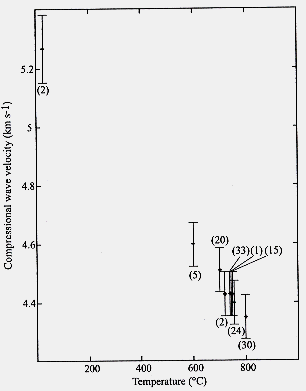

H2O, in fluids and hydrous phases, greatly influences physical and chemical processes in subduction zones, for example lowering the viscosity of both solid and molten mantle materials. H2O also lowers the solidus temperature of peridotite, the major rock type in the mantle wedge, thus fluxing the partial melting that produces arc magmas. The combination of high-pressure, high-temperature measurements of elastic properties of hydrous phases with the results of seismic tomography allows better understanding of H2O distribution in the mantle wedge above subduction zones.
Talc is likely to be an important hydrous phase at depths between 30 and 60 km, i.e. from the top of the mantle down to its pressure stability limit. At temperatures between about 620 and 680 ºC and pressures lower than 2 GPa, talc will be the primary hydrous phase in subduction zone peridotites. Therefore, we measured the compressional wave velocity, VP, in talc as a function of temperature at 0.5 GPa, using a time of flight ultrasonic method in an internally heated gas pressure vessel at Arizona State University, and the results are shown in Fig. 3.1-12.
Combining the results for talc with a previously published bulk modulus K and
 K/
K/ P gives a Poisson's
ratio,
P gives a Poisson's
ratio,  , of 0.268 and a shear modulus, G, of 22.6 GPa under
atmospheric conditions. Assuming
, of 0.268 and a shear modulus, G, of 22.6 GPa under
atmospheric conditions. Assuming  is independent of temperature
gives a
is independent of temperature
gives a  K/
K/ T value of -19.3 ±0.64 MPa K-1 at 0.5 GPa.
We used these experimental data, in combination with published data, to
calculate the Voigt, Reuss, and Hashin-Shtrikman-Walpole bounds, and the
Voigt-Reuss-Hill average of the elastic moduli of a peridotite hydrated
with talc, just above a cold subducting lithosphere, and derived seismic
velocities from those values. Our results suggest that a talc-
T value of -19.3 ±0.64 MPa K-1 at 0.5 GPa.
We used these experimental data, in combination with published data, to
calculate the Voigt, Reuss, and Hashin-Shtrikman-Walpole bounds, and the
Voigt-Reuss-Hill average of the elastic moduli of a peridotite hydrated
with talc, just above a cold subducting lithosphere, and derived seismic
velocities from those values. Our results suggest that a talc-
 |
bearing assemblage containing only 0.9 weight% H2O has elastic wave velocities (calculated from the Voigt-Reuss-Hill average) slower than the anhydrous rock by an average of 7.6% for VP, and 9.7% for shear waves Vs at 700 ºC, between 0.5 and 4 GPa.
These results can be examined in connection with seismic observations of converted elastic wave phase behavior near the surface of cold subducting slabs, e.g., in the northern Pacific. A layer of silica enriched peridotite just above the subducting slab, hydrated by talc, could explain these observations at depths shallower than 155 km (where talc is replaced by the 10 Å phase). This silica could come from mechanical incorporation of subducting sediments.
Another observation that can be explained by the presence of talc is the combination of low seismic velocities (5% lower than anhydrous peridotite) and a Poisson's ratio of 0.35, at about 40 km depth above the slab in central Japan. This has been attributed to the presence of serpentine. However, this interpretation requires either a completely serpentinized peridotite with no free fluid phase, or a partially serpentinized peridotite with a free fluid phase (the Poisson's ratio of a fluid is 0.5). This latter condition is unlikely, as a free aqueous fluid would drive the peridotite to full hydration. An alternative hypothesis is that a peridotite, with a free fluid phase, is fully hydrated with talc. Present efforts are directed towards construction of an assembly to perform ultrasonic interferometry in the internally heated gas vessel, and the investigation of the effect of H2O on the elastic property changes during partial melting.

Tel: +49-(0) 921 55 3700 / 3766, Fax: +49-(0) 921 55 3769, E-mail: bayerisches.geoinstitut(at)uni-bayreuth.de
 Previous page
Previous page